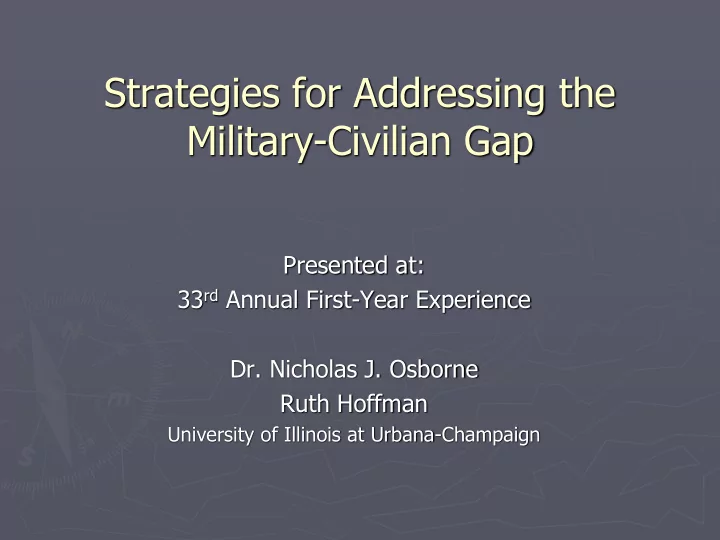

Strategies for Addressing the Military-Civilian Gap Presented at: 33 rd Annual First-Year Experience Dr. Nicholas J. Osborne Ruth Hoffman University of Illinois at Urbana-Champaign
What we will cover today Illinois Veterans Program Programmatic structure Transitional challenges (military vs. university culture) Structuring support Building community FYE Course Initial LAS-101 Course Fall 2014 Course Discussion
A few basics A different type of war Upgrades in equipment and Medical Evacuations = higher survival rate Multiple deployments Reliance on National Guard and Reserve Education New GI Bill Expected growth of student veterans (currently 4-percent of undergraduate pop.) Attrition (average benefit use is 16 months)
Exercise Close your eyes Take a few minutes and think about the word “veteran” What images come to mind? What emotions? What assumptions do you have? Where do you get your information from? Do you know any veterans on your campus? Hooyah!!! My story & My work
Program Beginnings Initial steps for starting the Veterans Office o Identified literature recommendations & anecdotal / site-specific needs Formulated a Veterans Advisory Committee Initial research: Survey, Focus Groups, Interviews ► Conducted with incoming veterans (first-year & transfer) and again one year later Designated quick fix (short-term) & complex (long-term) benchmarks Examples - Brochures & User-friendly Webpage (student input / adding section for faculty) - Events & Visibility - Faculty & Staff training - In-state tuition for out-of-state veterans - Credit for service - Veterans Lounge & Welcome Center
What did the research tell us? Key Points Transitional challenges Perceptions of climate Difficulty relating to peers Perceptions of the “traumatized” veteran Feeling isolated on campus
Transitional Challenges 1. Administrative (TAP limitations) - Applying to the University - Navigating through the sometimes confusing red tape of higher ed - Perceptions of campus climate 2. Transition Specific - Shifting from a structured environment to an independent lifestyle - Loss of community - Isolation 3. Personal - Reluctance to ask for help - Being singularly defined as “veteran” - Acquired disabilities – management and stigma
Challenges cont.’ Veteran Older, more likely to have dependents, commuters (less involved in activities) Self- reliant culture (“suck it up and drive on…”) Difficulty asking for help Break in education; feeling rusty and/or loss of confidence Perceptions of a “liberal” and “anti - military” environment Stigma of the traumatized veteran Loss of camaraderie & loss of personal mission ► “ Nick, I don’t relate to these kids” ► “I feel like my current life is mundane compared to being in Iraq” *Gender-specific stressors (MST, hypermasculine culture) Systemic Supporting military requirements (drill weekends, activations) Perceptions that Iraq & Afghanistan service = concern Viewing students exclusively as veterans. Assumptions of what veterans are like. A lack of understanding of military culture
Action Points Addressing the military-civilian gap Key features of how we address this at IL Identify veterans & communicate regularly ► Receive information of incoming veterans in advance – have a plan prior to their arrival ► Veterans Listserv - weekly emails & newsletter Connect Authentically ► In-person introduction (coffee) ► Vet Connect (student sponsor) & weekly social (30 – 40 students) ► Provide a veterans-specific orientation Provide venues for veterans to express themselves / tell their story ► Student Veteran Discussion Panels & Guest Speakers in classes ► Library Display, Recognition Ceremonies, Media Profile of a Student Veteran, Oral History Build relationships (internal & external) ► Professional development to faculty, staff and community (see “Questions to Avoid”)
Building community Connect to Campus Units Enhance Faculty Visibility Staff Training Veterans Support Incoming veteran Services Student Outreach Veterans Org. External (VA, VSO)
LAS First-Year Experience LAS - 101 Required for all first-term students Intern lead Model for special groups
Where we’re going… Fall 2014 Veterans Course First-year & Transfer Orientation – both on and off-campus resources - Guest speakers and team-building exercises - Mentoring - Practical skills (time management, note taking) - Reflective reading, journaling, and discussion - Mission / purpose development - Construction of gender / military culture -
Veterans Recognition
Questions to Avoid Compiled from survey data I conducted at the Department of Veterans Affairs, 2007-09 ► All for nothing, what a ► What was it like? / How waste, etc. (bad) was it? ► Did you kill anyone? ► What do you think about the war / the President? ► Are we winning? ► Did you see anyone die? ► Should we be over there? ► Talking about why we ► Are you OK (mentally)? shouldn’t be “there” ► Do you think you have ► Vietnam all over again PTSD? ► Do you have to go back?
“As a nation, we’ve learned to separate the warrior from the war…but we still have much to learn about how to connect the warrior to the citizen.” General Martin Dempsey
Closing Exercise Question, Quote or Comment (QQC) Reflect on 2-3 QQCs that arose from this session that you can take back to your school
Stay in touch Ruth Hoffman ruthhoff@illinois.edu Nicholas J. Osborne nosborne@illinois.edu Osborne, N.J. (2013). Veteran-ally: Practical strategies for closing the military-civilian gap on campus. Innovative Higher Ed. doi: 10.1007/s10755-013-9274-z, pp. 1 - 14 *Syllabus
Recommend
More recommend